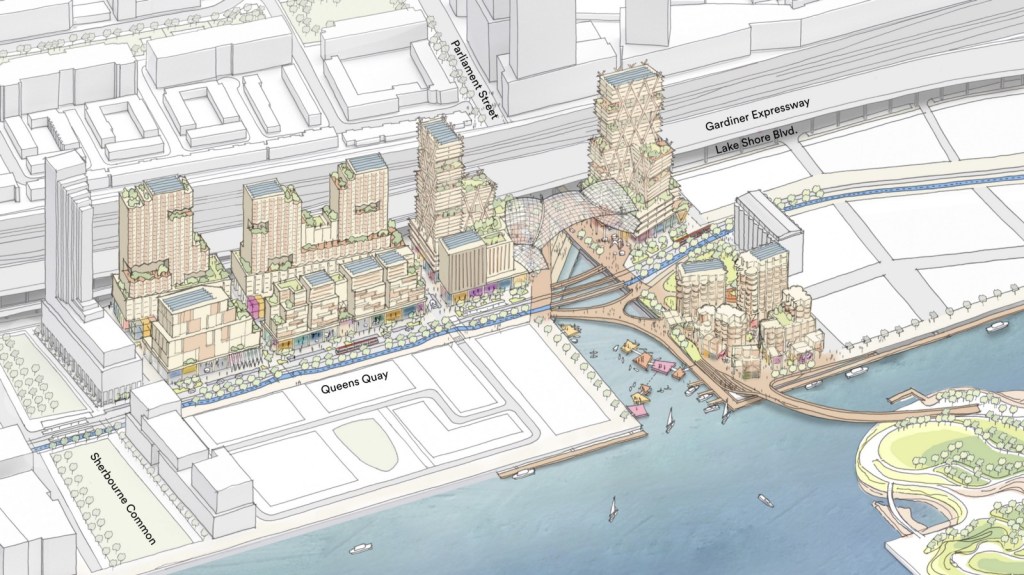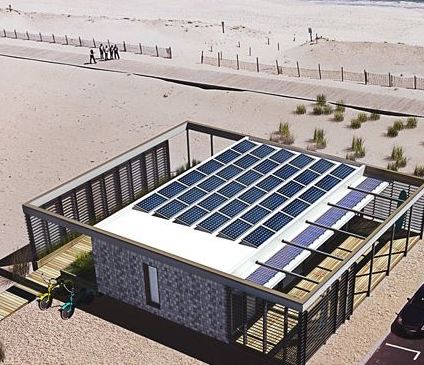Sidewalk Labs, the urban innovation organization of Alphabet, Google’s parent company, has plans for a new neighbourhood in Toronto. The 800-acre site, Quayside, will be the first of its kind. The Neighbourhood Hip innovation and practicality combine on the streets of Quayside. “Torontonians want more affordable housing, faster ways to get around the city, safer streets for pedestrians and cyclists, [and] a cleaner and healthier environment,” said Jesse Shapins, Sidewalk Labs’s director of public realm. “That’s what we are aiming to do by creating this new neighbourhood.” To fulfill this vision, the site will be composed of mixed-use developments and 12 mass timber buildings up to 30 stories tall. “If the primary load-bearing structure is made of either solid or engineered wood, it’s a mass-timber building,” says Tsay Jacobs director of the Building Technology Lab at Perkins+Will and a member of the International Code Council’s Ad Hoc Committee on Tall Wood Buildings. The recently reimagined building method is a risk, but it bears great promise. Mass Timber + Modular Construction Due to innovations in building technologies, the unique construction style is strong enough to support tall structures with timber frames. It is also non-combustible, a necessity for many existing building codes. Canadian builders lead the industry in mass timber construction. The new Toronto neighbourhood has several experts on hand. In addition to durability and safety, mass timber construction can also be more sustainable. Sidewalk Labs estimates that construction carbon emissions will be 75 to 85 percent less than conventional construction. How? A combination of mass timber construction with modular technologies will allow for a significant portion of the building to take place off site. Modular construction cuts back on street closures, traffic congestion, scaffolding construction, site congestion, and a host of other disruptions and safety hazards. “We can build and manufactured building and have it stacked in a matter of months and have almost none of that disruption,” says Karim Khalifa, Director of Building Innovation with Sidewalk Labs. “By manufacturing, we should be more efficient and be able to drop down the cost to build these buildings.” Modular building also cuts back on the cost of renovations in the future. Modular spaces can be more easily customized as the needs of the resident or tenant change. “I can take a wall panel, make it become unclipped, and a new wall panel will be clipped in. The turnover time now will only be weeks,” says Khalifa. Buildings that permit greater customization may minimize cost construction and urban sprawl. As young families grow into larger families, for example, they may be able to grow in place. Quayside neighbourhoods become fluid, shifting with the needs of the community. “The landlord has the flexibility of taking that unit that might be one bedroom and combining them into family units to keep people on site,” says Leslie Gash, VP Development at Waterfront. Getting Around Getting around will also be more efficient. Quayside plans to connect to light rail for quick transit throughout the metropolitan area. A flexible streetscape is also in the works. Though the plans are not complete, the streetscape will meet Vision Zero guidelines and be suitable for autonomous vehicles. To boost pedestrian transit and cut traffic, covered walkways called “stoas” will help protect walkers from the elements. A floating walkway will connect Quayside with Promontory Park, an anticipated new greenspace. Pedestrians can also access the new Silo Park, which will be the star of the Parliament Slip inlet attraction. Efficiency has been worked into the power infrastructure as well. Grid energy for the buildings will be supported by photovoltaic panels, battery storage, geothermal wells, and sewer heat recovery. The ambitious combination of alternative energies aims to break tradition with neighbourhoods that are dependent upon city utilities. The housing plan breaks barriers, too. Toronto has faced an affordability crisis for years. At least 50 percent of residences will be priced at 40 percent below market rate....
SURE HOUSE
Ultra low energy home
The SURE HOUSE strikes a balance between mitigating and protecting against the vagaries of climate change and extreme weather all under one charming, beach cottage roof. The winner of the US Department of Energy’s Solar Decathlon for 2015, the SURE HOUSE is an entirely solar-powered structure designed to make the most of the weather, including sunny days and stormy nights while providing its inhabitants with a comfortable, modern dwelling. Designed by the Stevens Institute of Technology, the SURE HOUSE rose to the top of a roster including 14 collegiate teams competing for a shot at developing the country’s most innovative, sustainable and marketable solar home. Occurring every two years, the Solar Decathlon challenges participants to design efficient, economical, and visually appealing solar-powered habitation. The teams must construct and operate their proposed habitats, which are then judged on “affordability, consumer appeal, and design excellence with optimal energy production and maximum efficiency.” With an eye toward the challenges posed by climate change and unpredictable weather patterns, the SURE HOUSE splits the difference between a charming beach cottage and hurricane safe-house. During sunny, mild days, the building’s design takes advantage of outdoor space by opening up to reveal a combination of decks and patios modeled after “the quintessential 60’s style modern beach cottage.” Its integrated solar panels, meanwhile, can produce up to 10,000 watts of power. While the design may be inspired by the 1960s, SURE HOUSE only requires 90% less energy than a conventional house. Its “ultra-low energy consumption” comes primarily from the incorporation of highly efficient appliances, including a solar-powered electric water heater and an energy recovery ventilation system, along with zoned heat pumps for heating, cooling, and dehumidification. Additionally, an extremely efficient building envelope helps manage indoor temperature and reduce HVAC demand. While the...


